Overview
This report is part of State of the News Media 2004, a annual publication of the Project for Excellence in Journalism.
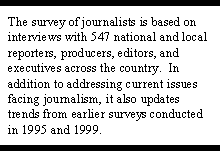
Journalists are unhappy with the way things are going in their profession these days. Many give poor grades to the coverage offered by the types of media that serve most Americans: daily newspapers, local TV, network TV news and cable news outlets. In fact, despite recent scandals at the New York Times and USA Today, only national newspapers and the websites of national news organizations receive good performance grades from the journalistic ranks.
Roughly half of journalists at national media outlets (51%), and about as many from local media (46%), believe that journalism is going in the wrong direction, as significant majorities of journalists have come to believe that increased bottom line pressure is “seriously hurting” the quality of news coverage. This is the view of 66% of national news people and 57% of the local journalists questioned in this survey.
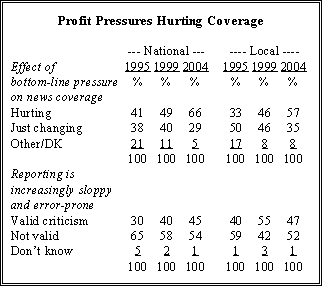
Journalists at national news organizations generally take a dimmer view of state of the profession than do local journalists. But both groups express considerably more concern over the deleterious impact of bottom-line pressures than they did in polls taken by the Center in 1995 and 1999. Further, both print and broadcast journalists voice high levels of concern about this problem, as do majorities working at nearly all levels of news organizations.
The notable dissent from this opinion comes from those at the top of national news organizations. Most executives at national news organizations (57%) feel increased business pressures are “mostly just changing the way news organizations do things” rather than seriously undermining quality.
The survey of journalists conducted March 10-April 20 among 547 national and local reporters, editors and executives by the Pew Research Center for the People and the Press in collaboration with the Project for Excellence in Journalism and the Committee of Concerned Journalists also finds increased worries about economic pressures in the responses to an open-ended question about the biggest problem facing journalism today. As was the case in the 1999 survey, problems with the quality of coverage were cited most frequently. Underscoring these worries, the polling finds a continuing rise in the percentage of journalists believing that news reports are full of factual errors. In the national media, this view increased from 30% in 1995 to 40% in 1999 to 45% in the current survey.
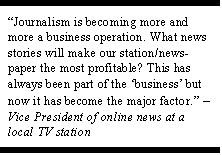
When asked about what is going well in journalism these days, print and broadcast journalists have strikingly different things to say. TV and radio journalists most often mention the speed of coverage the ability to respond quickly to breaking news stories while print journalists emphasize the quality of coverage and the watchdog role the press plays as the profession’s best features.
Journalists whose own newsrooms have undergone staff reductions are among the most worried that bottom-line pressures are undermining quality. Fully three-quarters of national and local journalists who have experienced staff cuts at their workplace say bottom-line pressures are seriously hurting the quality of news coverage. Those not reporting staff reductions are far more likely to say business pressures are just changing newsgathering techniques.

Beyond the stress of shrinking workplaces, there are a number of specific criticisms of the news media that are closely associated with the view that bottom-line pressure is hurting the quality of news coverage. First, there is almost universal agreement among those who worry about growing financial pressure that the media is paying too little attention to complex stories. In addition, the belief that the 24-hour news cycle is weakening journalism is much more prevalent among this group than among news people who do not view financial pressure as a big problem, and a majority says news reports are increasingly full of factual errors and sloppy reporting. And most journalists who worry about declining quality due to bottom-line pressures say that the press is “too timid” these days.
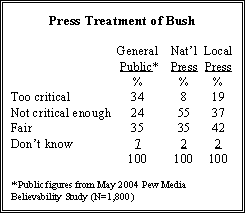
In that regard, the poll finds that many journalists especially those in the national media believe that the press has not been critical enough of President Bush. Majorities of print and broadcast journalists at national news organizations believe the press has been insufficiently critical of the administration. Many local print journalists concur. This is a minority opinion only among local news executives and broadcast journalists. While the press gives itself about the same overall grade for its coverage of George W. Bush as it did nine years ago for its coverage of Bill Clinton (B- among national journalists, C+ from local journalists), the criticism in 1995 was that the press was focusing too much on Clinton’s problems, and too little on his achievements.
There are significant ideological differences among news people in attitudes toward coverage of Bush, with many more self-described liberals than moderates or conservatives faulting the press for being insufficiently critical. In terms of their overall ideological outlook, majorities of national (54%) and local journalists (61%) continue to describe themselves as moderates. The percentage identifying themselves as liberal has increased from 1995: 34% of national journalists describe themselves as liberals, compared with 22% nine years ago. The trend among local journalists has been similar 23% say they are liberals, up from 14% in 1995. More striking is the relatively small minority of journalists who think of themselves as politically conservative (7% national, 12% local). As was the case a decade ago, the journalists as a group are much less conservative than the general public (33% conservative).

The strong sentiment in favor of a more critical view of White House coverage is just one way the climate of opinion among journalists has changed since the 1990s. More generally, there has been a steep decline in the percentage of national and local news people who think the traditional criticism of the press as too cynical still holds up. If anything, more national news people today fault the press for being too timid, not too cynical.
Not only do many national news people believe the press has gone too soft in its coverage of President Bush, they express considerably less confidence in the political judgment of the American public than they did five years ago. Since 1999, the percentage saying they have a great deal of confidence in the public’s election choices has fallen from 52% to 31% in the national sample of journalists.

Nonetheless, journalists have at least as much confidence in the public’s electoral judgments as does the public itself. In addition, the growing distrust in the public’s electoral decisions is not being driven by negative feelings about President Bush. Journalists who think the press is not critical enough of Bush are no more likely than others to express skepticism about the public’s judgments.
By more than three-to-one, national and local journalists believe it is a bad thing if some news organizations have a “decidedly ideological point of view” in their news coverage. And more than four-in-ten in both groups say journalists too often let their ideological views show in their reporting. This view is held more by self-described conservative journalists than moderates or liberals.
At the same time, the single news outlet that strikes most journalists as taking a particular ideological stance either liberal or conservative is Fox News Channel. Among national journalists, more than twice as many could identify a daily news organization that they think is “especially conservative in its coverage” than one they believe is “especially liberal” (82% vs. 38%). And Fox has by far the highest profile as a conservative news organization; it was cited unprompted by 69% of national journalists. The New York Times was most often mentioned as the national daily news organization that takes a decidedly liberal point of view, but only by 20% of the national sample.
The survey shows that journalists continue to have a positive opinion of the Internet’s impact on journalism. Not only do majorities of national (60%) and local journalists (51%) believe the Internet has made journalism better, but they give relatively high grades for the websites of national news organizations.
News people also acknowledge a downside to the Internet solid majorities of both national and local journalists think the Internet allows too much posting of links to unfiltered material. In addition, sizable numbers in the national (42%) and local samples (35%) say the Internet has intensified the deadline pressure they face. The changing media environment is generally having an impact on journalists’ workloads pluralities of national and local news people say they are increasingly rewriting and repackaging stories for multiple uses.
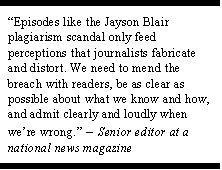
While journalists voice increasing concern over sloppy and error-filled news reports, there is no evidence that recent scandals like those at USA Today and the New York Times are having a significant impact on the way journalists view the profession. The number of journalists who cite “ethics and standards” as the biggest problem facing journalism has not grown since 1999. And most say that while plagiarism may be getting more attention these days, it is actually no more prevalent today than in the past.




